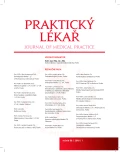Violence and aggression to professionals in healthcare facilities
Authors:
D. Magurová; Ľ. Majerníková; I. Ondriová; H. Galdunová; J. Janočková
Authors‘ workplace:
Prešovská univerzita v Prešove, Fakulta zdravotníckych odborov, Dekanka: Dr. h. c. prof. PhDr. Anna Eliašová, PhD., Katedra ošetrovateľstva, Vedúca: PhDr. Dagmar Magurová, PhD.
Published in:
Prakt. Lék. 2018; 98(1): 31-35
Category:
Of different specialties
Overview
The issue of violence and aggression in healthcare facilities is recently very topical, suggesting a need for deeper learning of the issue. It is important to realize that violence against doctors, nurses and other health care professionals on the violence in the exercise of their profession. Increasing cases where health professionals become the victim's in saving lives, verbal or physical aggression by treated patients and their relatives or involved people. So as to exclude violence as an undesirable social phenomenon from clinical and nursing practice, it is necessary to define the boundaries of what is considered in the healthcare setting for violence. It is necessary to develop concrete measures to protect healthcare workers when exercising their profession and offer them safety in health care provision. Health professionals in Slovakia should be better protected while exercising their profession, as it gained greater legal protection and that the status of protected persons. Since January 2017 the valid legal protection of medical personnel in the performance. Whether such legal protection reduces the incidence of aggression and violence against health care workers only time will tell.
Keywords:
violence – aggression – prevention of violence – medical offices – health care professionals
Sources
1. Bačišinová J, Galdunová H. Násilie v práci sestry a pôrodnej asistentky ako hraničná situácia. In: Šramka M, Bérešová A. Komplexná starostlivosť o človeka v hraničných situáciách. Prešov: Fakulta zdravotníctva a sociálnej práce bl. P. P. Gojdiča 2006; 14–16.
2. Krug EG, Dahlberg LL, Mercy JA, et al. World report on violence and health. Geneva: World Health Organization 2002.
3. Dolejší L, Švecová L. Násilí v ošetřovatelské praxi. Zdravotníctvo a sociálna práca 2012; 7(4): 62–63.
4. Európska agentúra pre bezpečnosť a ochranu zdravia pri práci 2003. Násilie na pracovisku [online]. Dostupný na: https://osha.europa.eu/sk/tools-and-ublications/publications/factsheets/24 [cit. 2017-02-12].
5. Gurková E, Gálliková D, Žiaková K, Grzywna T. Agresia pacientov a pracovná spokojnosť sestier vo vybranom zdravotníckom zariadení v Rakúsku. Ošetrovateľstvo 2015; 5(1): 6–12. Dostupný na: http://www.osetrovatelstvo.eu/_files/2015/01/6-agresia-pacientov-a-pracovna-spokojnost-sestier-vo-vybranom-zdravotnickom-zariadeni-v-rakusku.pdf
6. Hartl P, Hartlová H. Psychologický slovník. Praha: Portál 2000.
7. International Council of Nurses. Nurses, Always There for You: United Against Violence. Anti-Violence Tool Kit. Geneva: International Council of Nurses 2001; 41.
8. Jandourek J. Sociologický slovník. Praha: Portál 2007.
9. Kristová J. Komunikace sestry s pacientem s agresivním chováním. Sestra 2008; 18(12): 23–24.
10. Lepiešová M, Nemčeková M. Násilie a agresia voči sestrám pri výkone povolania. Sociológia 2013; 45(2): 172–194.
11. Mareš M. Otázky vymezení a typologie politického násilí. Politologický časopis 2003; 20(4): 338–347.
12. Occupational Safety and Health Administration. Workplace violence [online]. Dostupný na: https://www.osha.gov/SLTC/workplaceviolence/ [cit. 2017-11-29].
13. Ondrejkovič P. Násilie – spoločensky nežiaduci jav ako výzva pre sociálne profesie. In: Chytil O, Matulayová T. Výzvy pre sociálne profesie v modernej spoločnosti. Prešov: PU Filozofická fakulta 2011; 124–144.
14. Pekara J., Trešlová M. Fenomén násilí v ošetřovatelství. In: Ošetrovateľstvo medzi teóriou a praxou: Pielęgniarstwo między teorią a praktyką. Bratislava: Slovenská komora sestier a pôrodných asistentiek 2011; 116–122 [online]. Dostupný na: http://www.prohuman.sk/files/osetrovatelstvo-medzi-teoriou-a-praxou-2011.pdf#page=70 [cit. 2017-11-29].
15. Zelman M, Hollý K, Bračoková H. Zvládanie akútneho psychomotorického nekľudu a agresivity pacienta. Psychiat. pro praxi 2006; 6(4): 185–190.
16. Šimkovič M. Zdravotnícki pracovníci získali postavenie chránenej osoby [on line]. Dostupný na: http://www.pravo-medicina.sk/aktuality/1161/zdravotnicky-pracovnici-ziskali-postavenie-chranenej-osoby [cit. 2017-11-29].
17. World Health Organization. Preventing violence and reducing its impact: How development agencies can help 2008; 4–37 [on line]. Dostupný na: http://apps.who.int/iris/bitstream/10665/43876/1/9789241596589_eng.pdf [cit. 2017-11-29].
18. World Health Organization. Changing cultural and social norms that support violence s. 1–18. [on line]. Dostupný na: http://apps.who.int/iris/bitstream/10665/44147/1/9789241598330_eng.pdf [cit. 2017-11-29].
Labels
General practitioner for children and adolescents General practitioner for adultsArticle was published in
General Practitioner

2018 Issue 1
Most read in this issue
- Acute renal failure and acute kidney injury
- Violence and aggression to professionals in healthcare facilities
- The current view of carbon monoxide poisoning in the Czech Republic
- The patient has a family! Individualised care from a systemic perspective
